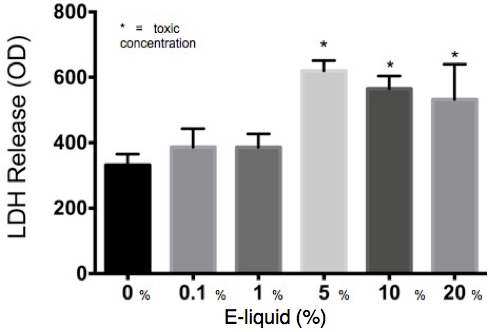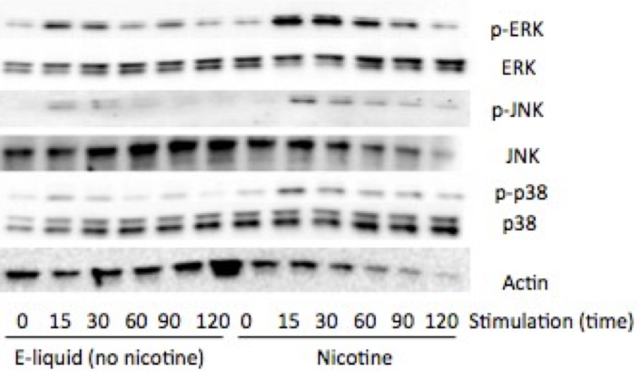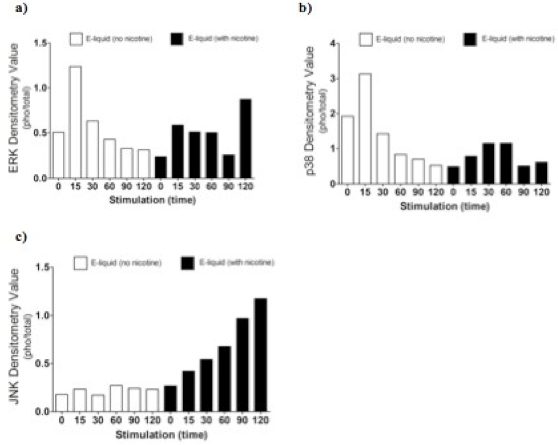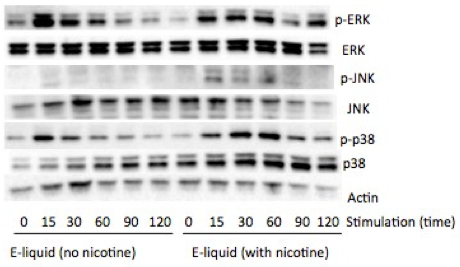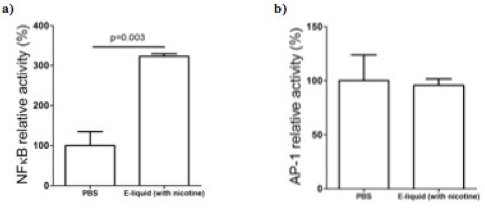Featured Article:Are E-Cigarettes a Safe Alternative to Smoking? Using Airway Cell Cultures to Assess Early Indicators of COPD Progression
By
2015, Vol. 7 No. 05 | pg. 2/2 | « ResultsFigure 5. The results of the LDH Assay show that E-liquid (minus nicotine) is significantly toxic to cells at a concentration of 5% or higher. Figure 6. Western blots of MAP kinases.
An LDH assay was performed to examine whether E-liquid induced airway epithelial cell death. Significantly elevated levels of LDH were observed in the media from cells exposed to greater than 5% E-liquid, implying that this concentration was toxic to cells. The increase in LDH released was proportional to the amount of cell death. Subsequently, to assess the effects of subtoxic doses of E-liquid on protein function, cells were treated with 1% E-liquid and MAP kinase activation was examined. 1% E-liquid was the highest dose shown to be non-toxic in the LDH assay. Western blots were performed for the following targets: p-ERK, p p-38, p-JNK, p38, JNK, ERK and Actin in cells exposed to nicotine alone (Figure 6) and E-liquid with nicotine (Figure 8). Actin was used as an internal control because Actin is consistently expressed, so the measure of its protein density is a useful loading control for protein. Nicotine alone and E-liquid minus nicotine were used as controls for the study. Nicotine appeared to activate MAP Kinases. MAP Kinases were activated both by the E- liquid without nicotine, and nicotine alone. To semi-quantify the level of activation of the MAP Kinases, a ratio of phosphorylated to total proteins was calculated through densitometry analysis (Figure 7). ERK activation peaked at both the 15-minute mark and the 120-minute mark (Figure 7). p38 activation increased steadily from the 0 minute to 30 minute mark, but remained constant thereafter (Figure 7). JNK activation steadily increased over time (Figure 7). ERK, JNK and p38 were significantly activated by nicotine alone. JNK activation remained relatively stable at the 15 and 30 minute marks, and peaked at the 120-minute mark. ERK, JNK, and p38 were also significantly activated by E-liquid containing nicotine. To assess the effects of E-liquid containing nicotine on transcription factor activation, NF-kappaB and AP-1 activations were measure using a Transcription Factor Assay (Figure 9). E-liquid containing nicotine significantly increased activation of NF-kappaB, but not AP-1. Therefore, the graph suggests that E-liquid containing nicotine did not activate AP-1. DiscussionThe potential impact of safer alternatives to cigarettes products has major public health implications. However, many alternatives on the market have yet to be proven safe. This study was an attempt to assess the toxicity of E-cigarette cigarette vapors (E-liquid) on lung cells and the subsequent impact on inflammation mediators, such as kinases and transcription factors. Our data show that E-liquid significantly induces cell death, activates MAP kinases ERK, p38, JNK and the transcription factor NF-kappaB, suggesting that signaling associated with inflammation is occurring when the cells are exposed to E-cigarette vapor. Cigarette smoke is a known activator of MAP kinases [1], so this finding is not surprising and suggests that nicotine may be involved in kinase activation as both E-liquid and cigarette smoke contain nicotine. Future studies examining whether the degree of protein activation is greater due to nicotine would be useful. Additionally, in vivo studies in animals would enhance the results of this study and suggest potential human implications of using E- cigarettes. My data also strongly demonstrates that when cells are treated with E-liquid, NF-kappaB is activated. NF-kappaB can regulate the induction of many detrimental genes, such as cytokines and proteases, that are associated with progression of COPD. This study was performed in the laboratory of Dr. Foronjy. Dr Foronjy [unpublished data] recently determined that when lung epithelial cells are treated with E-liquid, cytokine and protease gene expression (e.g. MMP-7, MMP-9, Cathepsin L1 TLR3, c-Src) associated with disease progression increases. This study hypothesized that when cells are treated with E-liquid, MAP kinase activation could induce subsequent NF-kappaB activation and then the production of cytokines and protease genes. In future experiments ERK, p38 and JNK could be knocked down using silencing RNA (siRNA), and cytokine and protease levels could be analyzed. These experiments could determine whether the aforementioned MAP kinases are integral to the E-cigarette mediated induction of responses associated with lung damage. Cigarette smoke is known to be a major risk factor for numerous diseases, including COPD. This project suggests that E-liquid used in E-cigarettes could also be potentially harmful to human health, and contribute to COPD progression. This study attempted to assess the lung toxicity of E-liquid in vitro. Future assessment of E-cigarette health effects in vivo in both animal and human models would be useful in understanding the long-term effects of E-cigarette usage on disease. Furthermore, in vivo work may allow scientists to find the specific proteases and cytokines that could serve as biomarkers for inflammation ordisease. Medication to control these protein levels may be developed accordingly, but the best approach would be to minimize the use of tobacco products independent of their delivery method. References
*Image Attribution: Cover image thanks to vaping360.com Suggested Reading from Inquiries Journal
Inquiries Journal provides undergraduate and graduate students around the world a platform for the wide dissemination of academic work over a range of core disciplines. Representing the work of students from hundreds of institutions around the globe, Inquiries Journal's large database of academic articles is completely free. Learn more | Blog | Submit Latest in Biology |

